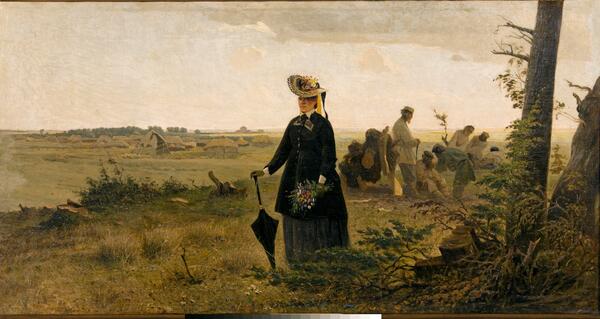The Ostrogozhsk Museum of History and Art features a painting titled “The Death of Vikulin’s Grove” by Lev Solovyov. The scene had its roots in the times of Peter the Great when in 1701 the tsar-reformer ordered to plant foreign trees, bushes, and flowers on the bank of the Voronezh River. This garden was funded by the public treasury and became the favorite leisure area of Voronezh citizens. In 1798, trying to cut down the expenses, Emperor Paul I gave the garden to the landowner Alexey Vikulin who invited talented serf gardeners. Although the garden became private property, it remained open to the public. Shortly before the Revolution of 1917, there was an acute need to provide the city with fuel, and the trees in Vikulin’s Grove were felled to make logs for the fire. The artist depicted that sad event.
Lev Grigoryevich Solovyov was born into an ordinary peasant family in the village of Lushnikovka, Ostrogozhsky Uyezd, Voronezh Governorate. He had a difficult childhood and was forced to work as a shepherd, a common laborer, and a guide to blind people. However, Lev Solovyov reminisced that as a child he used to draw something all the time. He did not have paints and used chalk and coal instead. His fascination with drawing was noticed by a visiting icon painter who took the talented boy to Voronezh. There, Lev Solovyov painted in a workshop and engaged in self-education. Soon, his thirst for knowledge drove the young artist to St. Petersburg where he attended classes at the Academy of Arts as a non-matriculated student. His paintings were often exhibited and highly praised by art critics. However, Solovyov was not comfortable with the hectic atmosphere of the St. Petersburg high society, and after spending six years in the Russian capital, he returned to Voronezh.
Lev Solovyov was a very popular and respected man in Voronezh: he depicted the images of saints, painted churches upon commission of the local diocese, and contributed to the development of the Voronezh Region by co-founding a free public drawing school and thus providing opportunities to numerous young and talented artists.
Solovyov created genre paintings and portraits, illustrated the works of Nikolay Nekrasov, published articles on art and reviews of exhibitions in the “Don” newspaper, and wrote poetry. When an art gallery was opened in Ostrogozhsk in 1910, Lev Solovyov donated a series of his works to his hometown. Unfortunately, many of them were lost during the years of German occupation.
Lev Grigoryevich Solovyov was born into an ordinary peasant family in the village of Lushnikovka, Ostrogozhsky Uyezd, Voronezh Governorate. He had a difficult childhood and was forced to work as a shepherd, a common laborer, and a guide to blind people. However, Lev Solovyov reminisced that as a child he used to draw something all the time. He did not have paints and used chalk and coal instead. His fascination with drawing was noticed by a visiting icon painter who took the talented boy to Voronezh. There, Lev Solovyov painted in a workshop and engaged in self-education. Soon, his thirst for knowledge drove the young artist to St. Petersburg where he attended classes at the Academy of Arts as a non-matriculated student. His paintings were often exhibited and highly praised by art critics. However, Solovyov was not comfortable with the hectic atmosphere of the St. Petersburg high society, and after spending six years in the Russian capital, he returned to Voronezh.
Lev Solovyov was a very popular and respected man in Voronezh: he depicted the images of saints, painted churches upon commission of the local diocese, and contributed to the development of the Voronezh Region by co-founding a free public drawing school and thus providing opportunities to numerous young and talented artists.
Solovyov created genre paintings and portraits, illustrated the works of Nikolay Nekrasov, published articles on art and reviews of exhibitions in the “Don” newspaper, and wrote poetry. When an art gallery was opened in Ostrogozhsk in 1910, Lev Solovyov donated a series of his works to his hometown. Unfortunately, many of them were lost during the years of German occupation.


